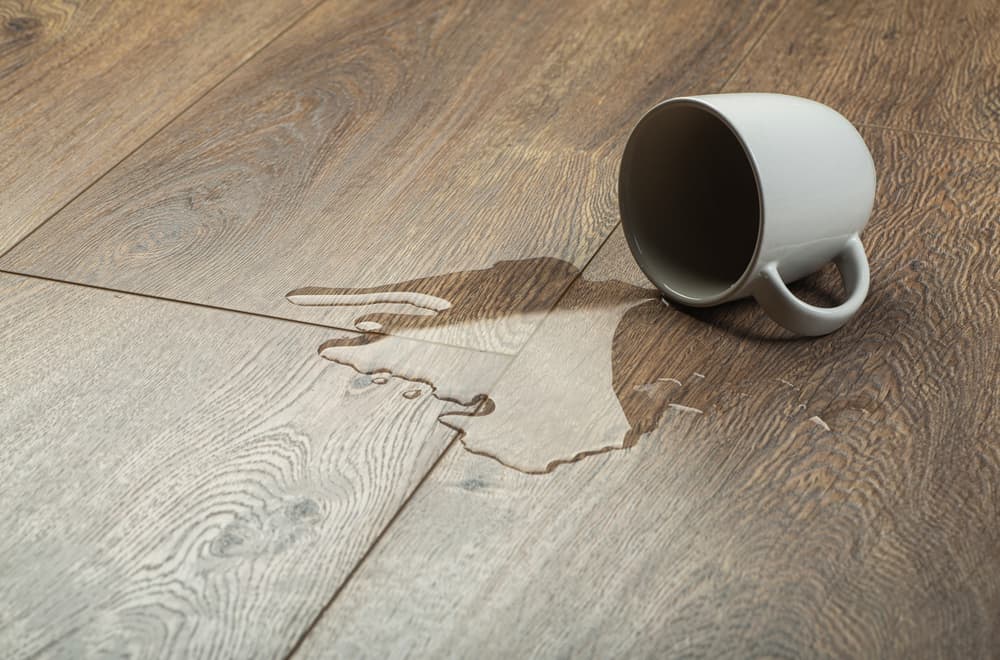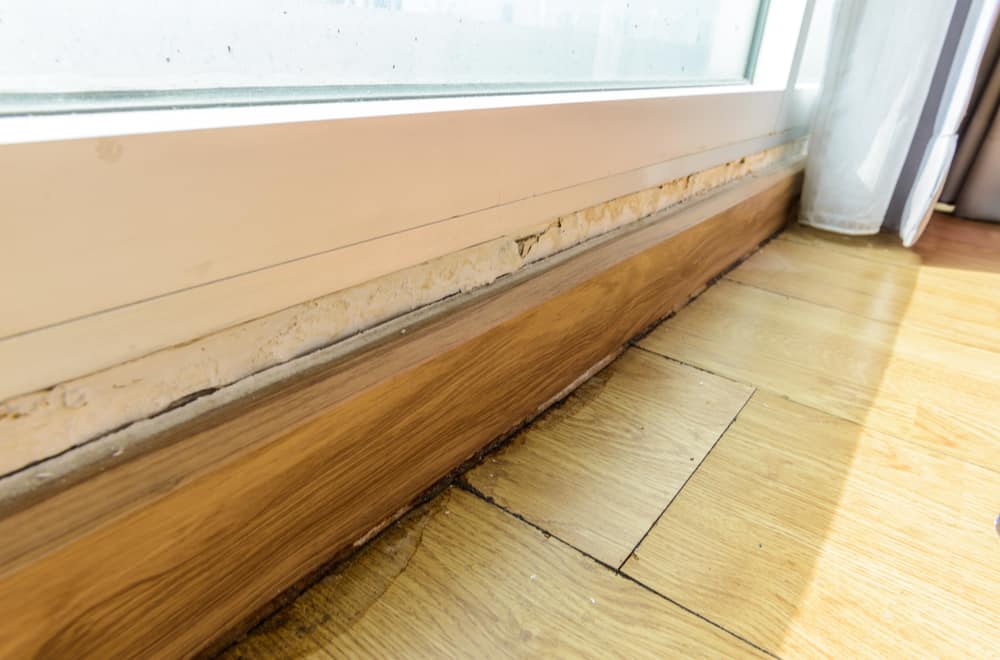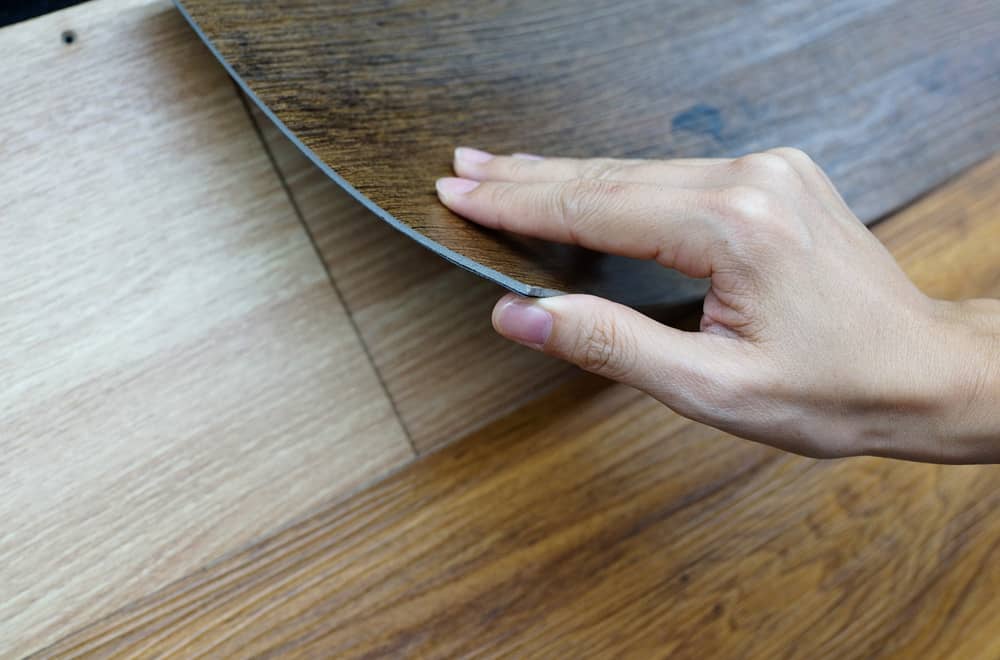Having water under vinyl plank flooring is one of the issues we often hear homeowners complain about.
We love vinyl flooring as they have many positive attributes; it is budget-friendly, hard-wearing, and it looks convincing as hardwood, ceramic, and marble. Unfortunately, moisture can damage even the most expensive and professionally installed vinyl floor.
Why does this happen? In this article, you will learn:
- What causes the accumulation of water under vinyl plank flooring
- What to do when this problem arises
- How to spot early signs of deterioration in vinyl floors… and more!
Table of Contents
Is Vinyl Plank Flooring Waterproof?
Yes! The best thing about vinyl flooring is that they are designed to be waterproof from top to bottom. If you find it hard to believe, you can test it for yourself by submerging a vinyl plank in a tub for several hours or even days, and you will find it stout and undamaged.
Luxury vinyl plank flooring, in particular, is among the best choices to install in bathrooms, basements, laundry rooms, and kitchens. The planks comprise layers of fiberglass, resins, and other chemical plasticizers. This multi-layered structure provides each plank a dense, unmalleable, and sound-suppressing core impervious to water.
Now, the question is — why do homeowners still find water under vinyl plank flooring? It is not because vinyl planks are porous; they are not.
What Causes Water Under Vinyl Plank Flooring?
We have already established earlier that vinyl planks are waterproof in themselves. But although vinyl planks are remarkably durable, it is still possible for water to get under it and here are the most common reasons why.
1. Low-quality vinyl flooring
Vinyl composite tile is the first widely popular form of vinyl flooring, and it remains all the go in commercial and institutional applications because it is a relatively inexpensive flooring option. DIY enthusiasts also like them as they come in a variety of colors and patterns, plus they are a breeze to install.
However, having many seams between the tiles means vinyl composite tile flooring will not be as moisture-resistant as luxury vinyl flooring. The prevalence of seams allows more opportunities for water to seep down into the subfloor, wash out the adhesive, and cause the tiles to separate from the subfloor.
To put it simply, this type of flooring is not at par in terms of the moisture tolerance and overall durability that its more expensive counterparts have.
2. Improper installation
A luxury vinyl flooring or click-lock vinyl system does not automatically mean your floors will be free of moisture. Water can get through the seams, tongue, and groove locking mechanisms if you fail to snap the boards together because it leaves small gaps between them. Otherwise, properly installed vinyl planks will prevent water from penetrating and they stand up to humidity levels pretty well.
Moreover, installing luxury vinyl tiles over concrete increases the chances of moisture accumulation underneath and the tiles react with the high-alkaline chemicals emitted from the slab. For this reason, you will want to perform moisture testing followed by other control measures to stop concrete sweating.
3. Chemical exposure
Road salts and ice melters that come in with snow are highly alkaline, causing quick adhesive deterioration and eventually, this allows moisture to set foot underneath. If you are worried about your kids tracking in snow, you will want to use a good mat to help keep those damaging compounds off the floor. Fortunately for floating luxury vinyl flooring, this is not much of a concern.
4. Flooding
As they are non-porous, vinyl tiles do not absorb spills and pet accidents. But in the case of an extreme water incident, water will make its way through the seams or the places where the planks connect due to constant pressure.
The most common culprits when it comes to this case are:
- condensation from unconditioned crawl space
- pipe leakage in the subfloor
- mechanical problems with the dishwasher and washing machine
- natural floods or continuous leaks coming in through a window
Those spills and pet accidents will not cause significant problems, but of course, it is necessary that you wipe off standing water immediately.
What Are Signs There’s Water Under Vinyl Plank?
As soon as you notice one or more of these signs, you should deal with it as soon as possible because the problem gets exponentially worse more than as fast as you might expect them to be.
- Buckling
Raised edges are a major sign of moisture and while it can occur in all types of vinyl floor systems, it is often seen in glued-down flooring due to adhesive deterioration.
- Dampness
Vinyl tiles rarely get cold since they have insulative properties, and therefore, it is a sure sign that moisture has gotten underneath them if you feel cold when you walk over.
- Shifting
Movement is another telltale indicator that the connections between the planks and subfloor have detached due to moisture accumulation. Similarly, the extreme heat from the sun can also expand the bond of the glue, causing the tiles to shift.
- Swelling
The appearance of bubbles, ridges, and bumps occur when moist air rises from below. Oftentimes, these little air pockets appear following a flood or any immense exposure to water.
The good news is that tiny air bubbles will disappear just with time. For big air pockets, you can inflate them by making a direct poke using a tiny pin followed by running a card over the area.
- Molds
If there is anything more annoying than bubbles, it is the ghastly appearance of mold or mildew and the musty smell that comes with them.
You will often see molds in vinyl floors installed in basements and other humid areas that receive little attention. Although vinyl is mold-resistant, the fungi can proliferate in the seams and receive sustenance from dirt, dust, and sugars that settle on the floor.
You do not have to wait for these signs to materialize. Get a moisture meter and check your floors. If the moisture level is less than 5%, you can dry the water using a dehumidifier or a heater.
How Do You Dry Water Under Vinyl Plank Flooring?
If there is little moisture under the floor, it may evaporate by increasing room temperature for one or two days.
But in the case of a flooding incident or a nasty plumbing leakage, accumulated water under vinyl plank flooring will not dry on its own because there is too much condensation trapped between the vinyl planks and substrate or underlayment.
Since the heater is not enough to parch the floors, you sadly have to uninstall the pieces that exhibit the most signs of moisture and often these are planks with already warped and curled edges. In doing so, you will want to use a floor scraper when removing the glued planks. Once removed, run the dehumidifier 24/7. Hopefully, you also have a few extra boards saved from the original install.
For a click-lock vinyl flooring, uninstalling the boards is not much of a problem but unfortunately for glued-down boards, utmost precision is required to prevent further damage. Ideally, you will want to seek help from an expert.
Equally important, check your crawl space and ventilate if needed. If the subfloor is wood, it is likely that moisture is seeping up from the crawl space and therefore, you will need to condition it to prevent vapor drive.
Summary
Vinyl planks are waterproof, but there will be instances where flooding or unexpected plumbing problems occur and moisture will inevitably build up under the floor. Therefore, you should:
- Always check for visible signs of moisture, especially right after your floor has been exposed to water for an extended period.
- Standing water, such as pet messes and chemical spills, should be wiped off immediately.
- Save a few extra boards from the original install as you will use them for future repairs. It is always better to remove damaged planks and replace them with ones.
- Dry the subfloor using a dehumidifier and use a moisture meter, so you know you are in the clear before installing new boards.
- If you are looking to install new flooring, it is wise to opt for luxury vinyl planks because they are less likely to show signs of wear and tear due to the click-and-lock design. As you may already know by now, different vinyl flooring options also have different levels of moisture tolerance.
- Mitigate moisture from the onset by creating a conditioned crawl space.
That’s it. I hope you find this article helpful. If you do, it would be nice to share it to your friends or comment down below if you have questions!



Do you have to have a older concrete floor sealed before having flooring laid such as vinyl floor planks..the slab house was built in the 70s ..I have had plans down for 2 years and have found my hallways have created moisture and lifting of the planks.
Hi, Dealer told me that since one corner of my place got water damaged so water traveled under the SPC and or trough the concrete and caused damage, so i asked how that possible since the manufactures says 100% waterproof, He said the minimum water or the moist cause damp underneath and that caused the cupping of the SPC.
Please explain it to me the way that i understand it too.
Hi I am having problems with my vinyls floors that I got installed last year. Just noticed a lot of water underneath the floors. Is it caused from condensation? When they installed the floors they put under layers for moisture. Why is this happening?
Poor installation. Contact the company who installed them. They need to sort this out for you.. It should be guaranteed workmanship as well as guarantee on the floor vinyls.
If water got under LVP that was installed but not finished/no caulk in bathroom (crook stole 1000$ of flooring). Water from shower spilled onto bathtub edge. 2 professionals looked the next day. I asked them to pull LVP to dry: both said no need and to keep fan on. It will dry. 2 days later it smelled like mildew. Now a couple planks were pulled and propped up for fan to dry for days (more than needed/little water spot in middle). I sprayed microban underneath and smell is gone. Is that enough or does it need other treatment under before reinstalling?
We had a clog from washing machine that caused water to bubble up and leak under our vinyl plank floorings. It appears the water is gone and no visible damage to floor. The clog is clear for now but need to call another plumber to make sure. No more water but worried about mold? Possible it dried out enough to not have to pull up flooring?